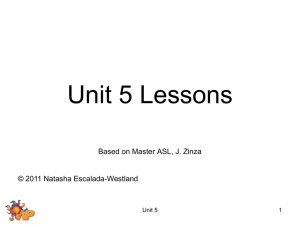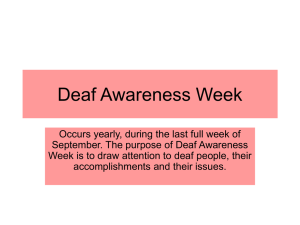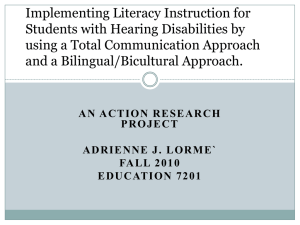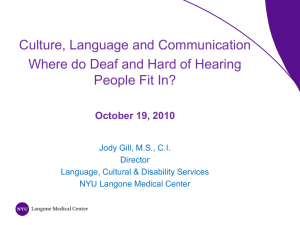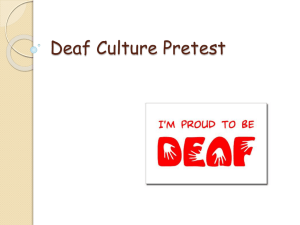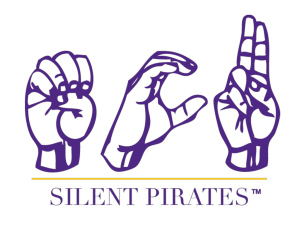MASL Unit 9 a masl_unit_9_lesson_1-5
advertisement
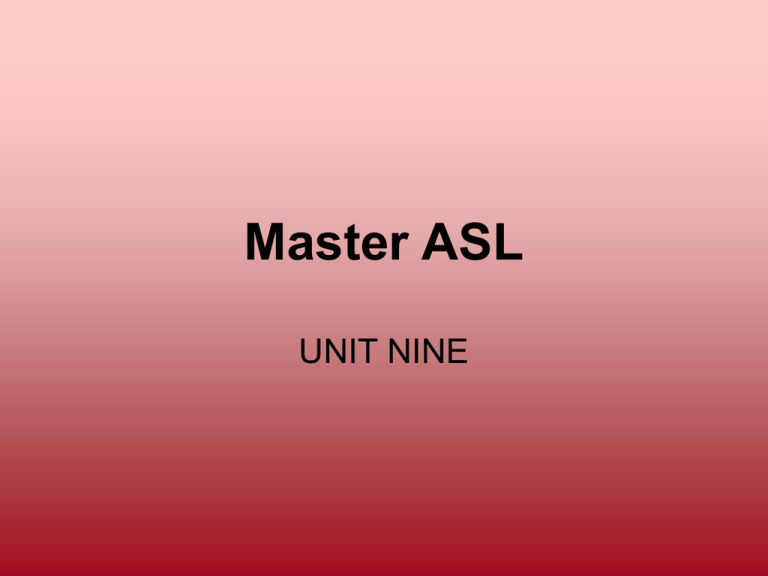
Master ASL UNIT NINE MASL 9 Objectives: • To describe your home and community • To sign money using the Money Spot and dollar Twist • To describe objects using spatialization techniques • To understand and give street directions • To understand how social changes affect the Deaf World • To learn and apply non-manual signals Unit 9 Vocabulary Links • http://www.youtube.com/watch?v=ceKQB0 48Ryw&feature=related Master ASL UNIT NINE Lesson 1pp MASL 9 – Lesson 1 pp 332-335 Housing, places around the house, using HAVE, Outcomes: • Communicates about housing options; • Can explain the type and number of rooms in a house; • Uses HAVE to elicit information MASL 9 – Lesson 2 pp 336-338 Spatial visualization; Eyes on ASL #16; Signer’s Perspective; Outcomes: • Engages in spatial visualization when describing the interior of a house or other building; • Can visualize descriptions from the signer’s perspective. MASL 9 – Lesson 3 pp 339-346 Community Locations; Classifiers - Claw Outcomes: • Can communicate about places around the community; • Incorporates CL:Claw to give approximate locations or proximity of buildings or objects. MASL 9 – Lesson 4 pp 342-343 Focus: the Deaf and Hearing Worlds Outcomes: • Understands that the Deaf and hearing worlds are coming closer in various ways, increasing visibility and acceptance of Deaf people and ASL; • Understands the influence of film, media and television on bringing exposure to Deaf Culture. MASL 9 – Lesson 5 pp 346 Deaf Culture Note: Collective Values Outcomes: • Understands the concept of collective cultures; • Identifies elements of collectivism in Deaf culture • Contrasts individualism and collectivism. MASL 9 – Lesson 6 pp 347-351 Money; Eyes on ASL # 7 dollar twist; Eyes on ASL # 8 Money Spot; Lost & Found? Narrative Outcomes: • Communicates about money and prices; • Integrates the dollar Twist and Money Spot as needed when using money signs; • Comprehends the content of the Lost & Found? narrative. MASL 9 – Lesson 7 pp 352-337 Transportation; Classifiers Bent V; My commute Narrative Outcomes: • Can communicate about various transportation methods and options; • Integrates CL: Bent V into communicating about taking transportation; • Comprehends the content of the My Commute Narrative. MASL 9 – Journal pp 338 Deaf Peddlers; painting Milan, Italy, 1880 Outcomes: • Writes a personal response about Deaf peddlers; • And/or an argumentative essay about the Deaf World • Examines current challenges to ASL today, based on Mary Thornley’s painting, Milan Italy,1880. What’s your hometown like? • Hi, how are you? What’s your hometown like? I live in a very large city on the East coast that has at least a million people. Traffic is lousy, it’s crowded, and sometimes there’s smog, but I love it. Why? Because there is a lot to do. You can go dancing, to the zoo, there’s (sic) lots of different restaurants, and there are professional sports teams. Do you like where you live? • What’s your hometown like. Watch Marc sign in full motion on you student DVD. p 331 Vocabulary What’s your hometown like? Other new vocabulary seen in the narrative is presented throughout Unit 9 • Also • Curious • Different (plural) • East • Lousy • More than Curious is used to introduce a question or ask for an opinion Use this sign the same way you say...i was wondering...in English. Different uses a NMS. Use your lips to mouth dif-dif-dif. North, South, East and west are initialized signs. The direction of each sign depends on its compass point. MASL p 331 Where do you live? • In this section you will learn how to ask and answer questions about your home. • In the dialogue below see how the sign what kind? • Is used to inquire into a person’s living arrangement. p 332 Dialogue Translation? • Marc: what kind of home do you have? • Kris: I used to live in a house, but just moved into an apartment. What about you? • Marc: I live in a house with my family. p 332 MASL 9 – Lesson 1 pp 332-335 Housing, places around the house, using HAVE, Outcomes: • Communicates about housing options; • Can explain the type and number of rooms in a house; • Uses HAVE to elicit information Vocabulary Types of Housing • Fingerspell apt, (apartment) cabin, condo (condominium) duplex, studio, t-h (townhouse) • Dormitory • House • Mansion • Mobile home • What kind? MASL p 332 Classroom Exercise 1. Where do you live? What kind of home do you have? In complete sentences explain the following: • • • The type of home you live in bow The type of home you lived in as a child The type of home would want in the future. MASL p 332 Classroom Exercise 2. Dialogue Create a dialogue with a partner that includes the following: • • • • A greeting Asking at least two questions about housing Exchange information about a past or future move A conclusion and farewell MASL p 332 Classroom Exercise 1. Housing Describe the type of housing in each illustration. What can you say about each? An example is provided. MASL p 333 Classroom Exercise 2. I think….. What are the pros and cons of living in each type of housing? Think of two reasons you would like to live in the following places and two more reasons why you wouldn’t. Use the Listing and Ordering • • • • • • • • • • • • Beach house Apartment Dormitory Mansion Condo Mobil home Small house Mountain cabin Duplex Nursing home Studio Living with parents NMS Alert Mouth the word cha while signing big or mansion to emphasize an objects size. MASL p 333 ASL Up Close Using Have The sign to have can be used for possession, (I have a sister”) as well as to show that something exists (is there a bathroom?) In English you say “is there?” and in ASL you sign have. Use the Question-Maker NMS when using Have to ask a question. Is there an elevator? / Do you know if there is an elevator? Sign HAVE ELEVATOR ???? MASL p 333 Classroom Exercise 1. Using Have. You are looking for a home with certain features. Use have to ask a partner the following question, who will respond using the given information. An example is provided. Is there a basement? No there isn’t Is there an elevator? Yes, there is Is there a pool? Yes, there is Is there a garage? No there isn’t Is there an office? Yes there is Is there one bathroom? No there are two Is there a big kitchen? Yes, there is. Does it have AC? Yes, it does. Does it have a yard No, it doesn’t Is there a restaurant nearby? Yes, there is. MASL p 334 Classroom Exercise 2. Apartment Hunting Use have or how many to ask a partner question about the apartment. An example is provided. • How many bathrooms are there? HOW-MANY BATHROOM HAVE?? • There are three bathrooms HAVE 3 BATHROOM MASL p 334 Classroom Exercise 3. Dialogue. You and a friend are house-hunting for a place to live next year. Create a dialogue that includes the following: • • • • Discussion of the type of housing needed or wanted and why Comparing two alternative housing options, including two pros and cons for each Discussion of three must-have features and three features you do not want A conclusion MASL p 334 Vocabulary Places Around the House • • • • • • Basement Bedroom 1 Dining room Elevator Entrance, to enter Floor, level 1 • Garage • Kitchen 1 living room 1 floor, level 2 • Kitchen 2 • Kitchen 3 • Bedroom 2 • Living room 2 MASL p 335 Accent Steps Many signs for rooms around the house reflect the activity generally associated with that room. One cooks in the kitchen, sleeps in the bedroom, and eats in the dining room. In addition to concepts like these, several place signs use classifiers. Can you identify at least two sign that use classifiers? What do they show? MASL p 335 Classroom Exercise Characteristics. What rooms or amenities do the following places tend to have? In complete sentences use the Listing and Ordering Techniques to list a minimum of three different features for each. • • • • • • • • • • • • Apartment School Houseboat Workplace Mansion Townhouse Dormitory Cabin Restaurant Condominium Doghouse Large house MASL p 335 Homework Exercise 1 A. Compare and contrast the home you live in now and you ideal home. What differences do you want? Why? Use Shoulder Shifting and the Listing & Ordering technique in a minimum of six complete sentences. B. Few people ever stay in one place from birth to death. In a minimum of seen complete sentences describe where a person might live at the following ages. – 10 – 18 yrs old – 18 – 22 yrs old – 23 – 30 yrs old – 31 0 50 yrs old – 51 – 70 yrs old – 71 – 80 yrs old – 81-? Yrs old P 335 MASL 9 – Lesson 2 pp 336-338 Spatial visualization; Eyes on ASL #16; Signer’s Perspective; Outcomes: • Engages in spatial visualization when describing the interior of a house or other building; • Can visualize descriptions from the signer’s perspective. ASL Up Close Spatial visualization: Virtual Reality in ASL Spatial Visualization is the ability to describe spatial relationships both receptively and expressively. Spatial visualization describes the surrounding of house or other structure, describes where an objects is located in relation ship to other objects, and creates strong three-dimensional images. These skills are essential to sign complex thoughts and descriptions, to understand ASL literature, and to give and follow directions. MASL p 336 ASL Up Close All spatial descriptions start with the big picture or overall concept. House, two story. Then select a specific starting point, such as the front door, and describe what your eyes see as you move around, across, or through a room: stairs on left, couch in front of me, door to kitchen on right. Convey distance by using the sign over there with non-manual signals and eye gaze. Describe what you see in your mind’s eye! MASL p 336 ASL Up Close Some tips: • You are the reference point • Start general and as secondary details • Use eye gaze • Use non manual signals • If you’re watching something being described, look at things from the signer’s perspective, not your own. MASL p 336 Classroom Exercise Open your book to p 336. 1. Non-manual signals. Practice signing each non-manual signal accurately. MASL p 336 Classroom Exercise 2. Using NMS. • • • • • • • How would you communicate the following only using your eyes, eyebrows, lips, and head? Something on your right shoulder Something directly in front of your face, an inch from your nose Something on the floor to your left Something barely visible in the distance Something on a shelf across from and higher than your Two things at our immediate left and right MASL p 336 Classroom Exercise Open your book to p 337. 1. Spatial visualization. Describe each illustration based on the reference point marked X. MASL p 337 Classroom Exercise Open your book to p 337. 2.Layouts. Describe each illustration starting at the reference point marked X. an example is provided. MASL p 337 Classroom Exercise 3. Challenge. Use spatial visualization techniques to sign each description. Use proximity NMS as needed. 1. Open the door in the hallway. Right in front of you are stairs that lead up to the living room and down to the family room.. 2. In the living room there is a door on the immediate right, that area is the kitchen. Across from the stairs is a hallway that has two bedrooms on the left and one on the right. 3. Walk down the stairs to the family room. On the left across the room is the bathroom. On the far side is a door to the outside. MASL p 337 Eyes on ASL #16 MASL DVD • Visualize descriptions from the signer’s perspective • The signer’s right does not become your left or vice versa! • Visualize yourself in the signer’s position for the correct perspective. Classroom Exercise Open your book to p 338. 1. Using classifiers & NMS. Match the classifiers and NMS below with objects in the illustration. MASL p 338 Classroom Exercise Open your book to p 338. 2. Visualizing homes. Use visual spatialization skills to describe what you think the interior of each home looks like. MASL p 338 Classroom Exercise Open your book to p 338. 3. More layouts. Open your MASL book to pg. 338 Use visual spatialization skills to describe each layout. Remember to change to a bird’s eye perspective to your own. MASL p 338 Homework Exercise 2 A. What does the interior of your home look like? Describe its floor plan using visual spatialization techniques. Limit our description to a minimum of five complete sentences. B. Locate a photo of a suggested scene to describe using visual spatialization. Your description should have a minimum of five complete sentences. Possible descriptions: – A picture of a nature scene – A picture of a sporting event – A picture of a model home P 338 MASL 9 – Lesson 3 pp 339-346 Community Locations; Classifiers - Claw Outcomes: • Can communicate about places around the community; • Incorporates CL:Claw to give approximate locations or proximity of buildings or objects. Vocabulary • • • • • • • • • • • • • Places Around Town Clinic Clinician Convenience store / 7-11 Fire station Gas station Grocery store Hospital1 Hotel Jail Prisoner Museum Pharmacy, drug store Police station, officer, cop MASL p 339 Places Around Town • As you learn vocabulary for locations around your community, pay attention to those signs that can be paired with the Agent Marker. • These secondary meanings are printed in blue. • For example, adding the Agent Marker to jail creates the sign prisoner. p 339 Dialogue Translation? • Marc: What are you two doing? • Kris: We’re going to a movie. Want to go? • Marc: Sure! After I’m done at the bank. I’ll meet you there. p 332 Classroom Exercise 1. Dialogue I. Practice signing Kris’ and Marc’s dialogue with a partner. Add the following: • • • A greeting An introduction A specific time to meet MASL p 339 Classroom Exercise 2. Dialogue II. Create a dialogue with a partner on a topic that includes at least two different community locations. MASL p 339 I Want to Know… Why isn’t there a sign for station? Remember that English and American Sign Language don’t correspond word-for-word sign. In English, station refers to a location where a service or operation is performed. For several ASL signs, this meaning is already included in the sign. For example, people fill autos with gas at the gas station. Now make the sign gas station. What concept do you think it shows? Adding a separate sign for station would be redundant! MASL p 25 Classroom Exercise 1. Where are you? Explain the location and activity in each illustration in a complete sentence. MASL p 340 Classroom Exercise 2. What for? Explain why people go to the following locations. An example is provided. MASL p 340 Classroom Exercise 2. I nformation desk Ask your partner for the address of the following businesses in a complete sentence, your partner will provide the address. Switch roles and repeat when done. NMS Alert Mouth the word cha while signing big or mansion to emphasize an objects size. MASL p 349 Classroom Exercise Making???? • People & Places. Use the illustrations and your imagination to sign a complete sentence. • this man enjoys cars. He works at a gas station. MASL p 341 Homework Exercise 3 A. Locate the addresses of six places in your hometown. Sign the addresses and explain in complete sentences why people go to these places. B. Select five locations you go to often in you community. Use the Listing and Ordering Technique to explain what they are and what you do there. You should have a minimum of six complete sentences. P 341 Classroom Exercise 1. Using CL: Claw 5 Sign the following directions, using the CL: Claw 5 for the italicized terms. • My house is across from the school • The store is right next to the post office • The museum is behind the hotel • The café is on the other side of the book store • My office between a restaurant and the glower shop • His house is right around the corner from mine. MASL p 344 Classroom Exercise 2. More CL: Claw 5 Refer to the illustration to fill in the blanks with the correct locations. • see signed sentences and pic in book MASL p 344 EXPRESSION Use many mass to describe a bird’s eye view of many buildings or crowds of people. CORNER Many mass Classroom Exercise 1. Dialogue I Use the illustration in Exercise K to describe t\where the following places are located. • • • • • • • • • • Seafood restaurant Bank Gym Hair salon Post office Hotel Flower shop Park Gas station Pizza shop MASL p 345 Classroom Exercise 2. Dialogue II Create a dialogue with a partner about making plans to meet at a specific location. Your dialogue should include the following: • • • • • • Selecting a date and time to meet Selecting a place to meet An explanation of where the destination is located A minimum of two uses of CL: Claw 5 One use of ‘many mass’ A farewell MASL p 345 Classroom Exercise Using Finish Use finish to explain the different places you plan to go to today in complete sentences. Use your imagination to explain what you’ll do in each place. An example is provided. • After school I work. I work right by school. • pics MASL p 346 Homework Exercise 4 A. Describe your neighborhood. What types of stores or other places are nearby? Use CL: Claw 5 to help describe where you live in a minimum of six complete sentences. B. Use finish to explain the errands you might do on a weekend. Where will you go, and in what order? C. Write assignments A or B in ASL gloss. P 346 MASL 9 – Lesson 4 pp 342-343 Focus: the Deaf and Hearing Worlds Outcomes: • Understands that the Deaf and hearing worlds are coming closer in various ways, increasing visibility and acceptance of Deaf people and ASL; • Understands the influence of film, media and television on bringing exposure to Deaf Culture. Focus: The Deaf and the Hearing Worlds “Society regards the deaf as unfortunate. Is this general opinion nor largely due to self-regard, which makes us pity them the more for being unable to understand what we are saying?” -Nicolas Sabastian Roche de Chamfort Do you recall your first encounter with a deaf person or sign language? Did you watch Deaf individuals? Were you offered a card with the ASL alphabet on it by a deaf peddler? Did you have a Deaf neighbor or relative? For many people today, initial exposure to the Deaf community and ASL comes from seeing Deaf characters and sign language on television, the movies, or the theatre. From television commercials to comedies, Deaf actors in particular continue to expose the American public to the unique culture and language of the Deaf World. From, Marlee Matlin appearing on ‘Seinfeld” to the 2003 Broadway hit musical Big River the Deaf World is no longer hidden from the hearing public. MASL p 342 Focus: The Deaf and the Hearing Worlds “Society regards the deaf as unfortunate. Is this general opinion nor largely due to self-regard, which makes us pity them the more for being unable to understand what we are saying?” -Nicolas Sabastian Roche de Chamfort This interaction between the Deaf and Hearing worlds was not always the case. For many centuries deafness was considered a curse or divine punishment, and deaf individuals were often institutionalized or kept hidden from non-deaf family members and the public. Even in modern times sign language has been mocked and deafness pitied as an overwhelming communication barrier. MASL p 342 Focus: The Deaf and the Hearing Worlds Deaf West theatre, Inc. was founded in 1991 to enrich the cultural lives of the 1.2 million deaf and hard-of-hearing individuals who live in the Los Angeles area, and to expose the hearing world to deaf theatre. It provides exposure and access to professional theatre for deaf artists and audiences. All productions are presented in American Sign Language with simultaneous interpretation in English, providing an enhanced theatrical experience for deaf and hearing MASL p 342 audiences. Focus: The Deaf and the Hearing Worlds – This Bayer commercial is one of the first television commercials to feature a Deaf person using sign language. – This breakthrough opened the doors for Deaf people to appear in more commercials for popular products. MASL p 343 • • • • Add links to other deaf commercials Ipod Cpr Mc d Focus: The Deaf and the Hearing Worlds – As the hearing and Deaf worlds come closer together in mutually beneficial ways – such as the arts, theater, and film – the Deaf community has gained much exposure, understanding and appreciation by the hearing world. – One of the most important aspects of this appreciation and acceptance is the visibility of American Sign Language. – Not so long ago, many deaf people avoided signing in public because doing so drew stares, unflattering initiations, and condescension. – Hearing people, whether well-meaning or not, expected and demanded deaf individuals fit into the larger hearing world. – And thus differences were not embraced. MASL p 343 Focus: The Deaf and the Hearing Worlds – A Deaf time traveler from the past would be shocked to see how visible American Sign Language and Deaf people are in today’s world. – Much of this visibility comes from Deaf actors using sign language on television and the movies, a break-through that first occurred in 1968. – prior to that time, deaf characters were portrayed by hearing actors, with little thought of opening the door to deaf actors themselves. – Audrey Norton was the first Deaf actor to appear on television, and almost overnight other Deaf actors began appearing in numerous roles on television, commercials, movies and theatre production. – Now, American Sign Language is less of a novelty and simply a language used by millions of Deaf Americans, proudly visible in every part of the country. – Both the Deaf and Hearing Worlds have realized each has much to learn form the other in language, culture, and respect for differences. – And now both are able to freely exchange ideas and communicate on a level playing field. – The Deaf time traveler from the past would be astounded to realize that hearing people who watch Deaf people sign are more likely to be ASL students than people making fun of the language! MASL p 343 Focus: The Deaf and the Hearing Worlds – The visibility of American Sign Language on televisions shows, commercials, movies, and theater has evolved over the years due to the determination of Deaf actors proving they are as equally talented as their hearing counterparts. – In the words of the first Deaf president of Gallaudet University, Dr. I King Jordan, Deaf people can do anything …but hear. MASL p 343 Focus: The Deaf and the Hearing Worlds – Survivor, a popular reality television show, featured Christy Smith, a Deaf graduate of Gallaudet University. – Christy showed that she could interact with hearing people and compete on an equal footing. She was extremely popular with viewers. MASL p 343 ASL Up Close Using CL: Claw with spatialization • Convey distance between two places by using CL:Claw 5. • This classifier is a spatial placeholder for one or more places. • Concepts like nearby, not too far. Next to, across from, and more can be shown by varying the space between two hands forming the CL:Claw 5 handshape. • CL:Claw 5 is often used to describe the location of buildings or other structures in relation to each other. • In the example below notice how space is used with CL:Claw 5 to show distance between bank and salon, and then the empty space is identified as clinic. MASL p 344 MASL 9 – Lesson 5 pp 346 Deaf Culture Note: Collective Values Outcomes: • Understands the concept of collective cultures; • Identifies elements of collectivism in Deaf culture • Contrasts individualism and collectivism. Deaf Culture Collective Values • The dominant cultural value in the United States and Canada is called individualism. • Individualism is a social pattern or expectation that the individual is loosely connected to his or her community. • If personal goals conflict with group beliefs, individualists prioritize their personal preferences. • The dominant cultural value among the Deaf is called collectivism. • Collectivists consider themselves interdependent and closely linked together. • So a high value is placed on group harmony, solidarity, and cooperation. • When an individual behaves in a way that conflicts with Deaf culture’s group expectations or norms, then the individual may be seen as yielding to the more dominant values of hearing society. MASL p 346 Deaf Culture Collective Values • Behaviors considered rude in collectivist societies include the following: • bragging about one’s wealth or accomplishments, • acting in a manner that causes the larger society to view the smaller group negatively, • and avoiding social activities with other members of the community. • Because the Deaf World is so small, differences in income, education, employment, and other status symbols are deemphasized, traits that conflict with the larger hearing society’s values. • Similar to the experience of other minority groups, the Deaf community encounters criticism of its cultural values by hearing people who insist that Deaf must’ live in a hearing world.” MASL p 346 Where’s the rest of the Unit? • Focus questions, Lesson 6 & 7 and the Journal will be added when completed.
